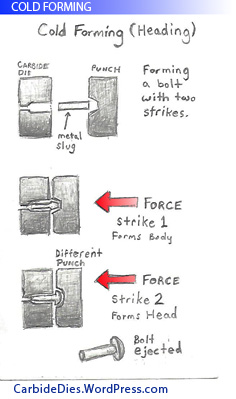Cold forming is a metal working technique used for rapidly forming steel parts such as screws, bolts and many other fasteners. Cold forming, also referred to as cold heading, uses a heavy strike against a cold metal slug to shape it into the shape of a Cold Forming Die. The force of the strike exceeds the metal’s yield strength, causing the metal to flow into the desired shape inside the carbide die.
The first step in colds forming is cutting the slug, also called a blank. Round wire from a coil is cut to the exact size needed. It is critical that the volume of the metal slug matches the volume of the finished product since cold forming process doesn’t add or take away any materiel.
After a metal slug is prepared the slug is then placed into the carbide die by the cold forming machine (or header) using “fingers”. The slug is then hit by one or more strikes (see figure 1). The carbide die and punch work together to create the new form. The force of the strike is great enough to cause the metal to momentarily become a fluid. This actually creates a stronger part than if the grain of the metal was cut into in order to form the desired shape. Often a progression of dies is used to achieve the final form desired. Each of these strikes are done at a different station and they progressively change the product into its final form. Most cold forming machines utilize either one or two strikes.
After the part is formed an ejector pin is then employed to pop it out of the machine. This, like the rest of the operations completed by a cold heading machine is completed at a rapid pace. Cold heading machines work at such a high rate of speed that the operations are invisible to the naked eye. Additional processes can be completed by these machines as well, for example, trimming, piercing and sharpening.
Obviously, this is a very brief description of cold heading and cold forming. We will continue with more in depth articles in the future.
